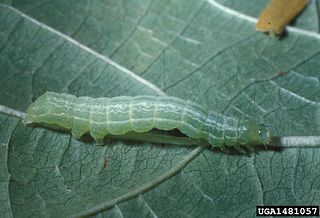Related Research Articles

Lophocoronoidea is a superfamily of insects in the order Lepidoptera. There is a single genus, Lophocorona, in the family Lophocoronidae. These are small, primitive nocturnal moths restricted to Australia whose biology is largely unknown.
Sir George Francis Hampson, 10th Baronet was an English entomologist.

Nepticulidae is a family of very small moths with a worldwide distribution. They are characterised by eyecaps over the eyes. These pigmy moths or midget moths, as they are commonly known, include the smallest of all living moths, with a wingspan that can be as little as 3 mm in the case of the European pigmy sorrel moth, but more usually 3.5–10 mm. The wings of adult moths are narrow and lanceolate, sometimes with metallic markings, and with the venation very simplified compared to most other moths.

Eupterotidae is a family of insects in the order Lepidoptera with more than 300 described species.

Urodidae or "false burnet moths" is a family of moths in the lepidopteran order, representing its own superfamily, Urodoidea, with three genera, one of which, Wockia, occurs in Europe.
Heliodinidae, commonly known as sun moths, is a family of small moths with slender bodies and narrow wings. Members of this family are found in all parts of the world.
Agathiphaga is a genus of moths in the family Agathiphagidae, known as kauri moths. This caddisfly-like lineage of primitive moths was first reported by Lionel Jack Dumbleton in 1952, as a new genus of Micropterigidae.
Herbert Druce, FLS was an English entomologist. His collections were acquired by Frederick DuCane Godman (1834–1919), Osbert Salvin (1835–1898), and James John Joicey (1870–1932) before being bequeathed to the Natural History Museum, London. He is not to be confused with his son, the English entomologist Hamilton Herbert Druce, who also worked on Lepidoptera.

Sematurinae is a subfamily of moths in the family Sematuridae represented by at least 29 species in the Neotropics.

George Talbot FES was an English entomologist who specialised in butterflies. He wrote about 150 scientific papers, the majority being primarily systematic, consisting of the description of new species or the revision of various genera. He was also responsible for the curation and preservation of the Joicey collection of Lepidoptera prior to its accession by the Natural History Museum.

The Thyatirinae, or false owlet moths, are a subfamily of the moth family Drepanidae with about 200 species described. Until recently, most classifications treated this group as a separate family called Thyatiridae.
Pogonogenys is a genus of moths of the family Crambidae.

Autoplusia is a genus of moths of the family Noctuidae.
Celonoptera is a monotypic moth genus in the family Geometridae. Its only species, Celonoptera mirificaria, is found in south-eastern Europe. Both the genus and species were first described by Julius Lederer in 1862.
Victor Gurney Logan Van Someren was a zoologist and entomologist.
Halysidota masoni is a moth of the family Erebidae. It was described by William Schaus in 1895. It is found in Mexico.
Aramos is a genus of moths in the family Cossidae.
Psychonoctua is a genus of moths in the family Cossidae. It ranges from California to Guyana, with one species in the Greater Antilles.
References
- ↑ Beccaloni, G.; Scoble, M.; Kitching, I.; Simonsen, T.; Robinson, G.; Pitkin, B.; Hine, A.; Lyal, C., eds. (2003). "Zeuzera masoni". The Global Lepidoptera Names Index . Natural History Museum.
- ↑ mothphotographersgroup
| This article relating to the moth subfamily Zeuzerinae is a stub. You can help Wikipedia by expanding it. |